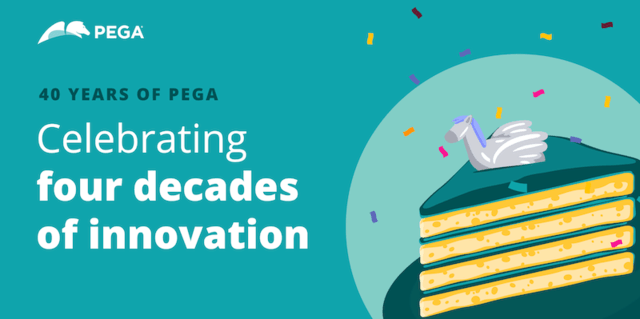This month marks Pega’s 40th anniversary. While I don’t attach a lot of significance to arbitrary milestones, I do appreciate this one as an opportunity to celebrate our ongoing success and those who made it happen and learn from the experiences that got us here. Technology has changed a lot in 40 years – those of us that follow it closely know that technology has changed a lot in the last 40 weeks – but I believe there are some fundamental truths we learned during our first 40 years of innovation that are useful to keep in mind as we think about the innovations to come. In the spirit of the four decades of innovation we are celebrating, here are four lessons learned through experience.
1. Technology must serve people vs. the other way around.
When I founded Pega, I did so with a mission to change how the world builds software. I was frustrated by how technical programming languages – basically archaic text files – slowed the pace of change and separated business users from the software they needed to run their businesses. Inspired by the way computer aided design (CAD) was transforming manufacturing, we developed a way to allow businesspeople to directly capture their requirements and objectives using visual tools and have Pega generate the running software automatically, without requiring code. At that time, this was called model driven development. Today it’s referred to as low code. And it’s still at the forefront of how organizations are adapting to disruptive change.
2. Software should be smart and should always be getting smarter.
One of my first jobs was teaching computer systems to play chess at the level of a grand master by teaching them the rules an expert human chess player uses to decide their next move. These expert systems were the forefront of artificial intelligence (AI). When I began to look at enterprise software systems, one my first questions was: “If we can teach a computer to play chess, why can’t we teach it to automate the work of processing a payment exception?” That’s why I’m so excited about the transformational power of Generative AI. We now have an ocean of intelligence at our fingertips. How can we apply it to drive real value for our customers, employees, and businesses?
3. You must be willing to consider when what you’re doing might no longer be the best path forward.
Innovation comes at the intersection of invention, a great idea, and persistence, then figuring out how to make it work. But you also must be willing to shift direction. We’ve rearchitected our software through five different generations to ensure we keep pace with new technologies, whether that was the birth of the browser, the emergence of Java, or the shift to the cloud. We’re fortunate to have teams who are not just willing but resolute about stepping away from something that is working and take a new uncharted path – and to have clients who see the value in that approach and have the confidence to go down that path with you.
4. The secret: Spotting true paradigm shifts amid the marketing hype.
Change often comes in two forms. There is the steady, incremental change you grind through every day – the persistence part of innovation. But changes often come suddenly, seemingly from nowhere. For example, AI has been making incremental shifts and progress for many years, but I doubt anyone anticipated the transformational impact that the release of ChatGPT would have. Being an innovative organization means you must build both the endurance needed for continual change and improvement as well as knowledge and confidence needed to know when to take big leaps. That means separating the hype – Metaverse, anyone? – from the truly big moments. Listening to the market and your clients is important, but you have to be willing to place your bets – and be aware when a change of direction is needed and have the courage to make that leap.
Build for Change®
Pega’s tagline has long been Build for Change®. That’s something our software, people, and partners help our clients do by building the right architectures, the right teams, the right methodologies. But it’s also a mindset we strive to live every day. What I’m most proud of in our 40-year history is how effectively we’ve changed and responded, evolved and transformed, while staying true to our core beliefs and values. It’s not the past we are celebrating, but the experience and knowledge gained that lets us innovate for the future.
Here's to the next 40 years!

